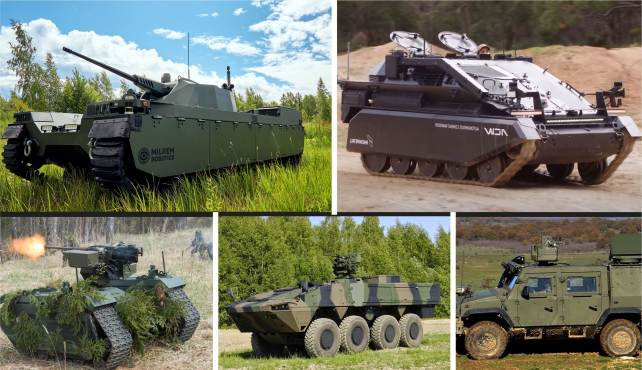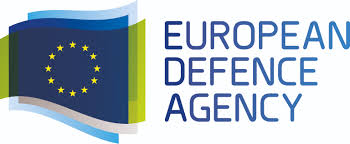
- Loading Mastodon feed...
The project, Combat Unmanned Ground Systems (CUGS), brings together nine member states and 28 European industry partners. With a € 35.5 million budget and running for 36 months, CUGS aims to define, design and develop a set of functional modules which will be mounted on to existing platforms. The final phase of the project will test full demonstrators for highly autonomous combat unmanned ground systems.
Autonomous systems provide operational benefits across a very broad range of missions, from intelligence, surveillance, reconnaissance and logistics missions to combat missions. Deploying unmanned systems reduces the danger to human personnel and manned platforms, while increasing robustness, sustainability and resilience of ground systems. It is expected that these systems will play an increased role in future Armed Forces by bringing faster manoeuvrability and more efficient and precise lethal and non-lethal effects, enhancing the efficiency and effectiveness of land systems and ensure an advantage in respect to the adversary.
CUGS – Adapting European Platforms
The functional modules to be developed in the project will ensure autonomous navigation; command, control, communications, and cooperation; and use of weapon systems. The modules will be integrated on several European autonomous ground systems; the mid-sized platforms Themis (Milrem, Estonia) and Wiesel (Rheinmetall, Germany), and large-sized platforms Type X (Milrem, Estonia), Lince 2 VTLM (Iveco, Italy) and Patria AMV (Patria, Finland).
The project will run across three phases; firstly, with the requirements and standard-based system architecture of the full CUGS demonstrator being developed for both the current autonomous platforms and future modules.
The adaptation of the five existing platforms will begin in parallel with the development of the combat functional modules. In the third phase of the project the solutions will be mounted on the platforms and will be tested and evaluated individually and in a cooperative way in relevant environments.
In the testing phase, the adapted unmanned ground systems should be able to autonomously move, navigate, communicate, detect, identify and lock targets, choose weapon systems and test firing sequences and safety aspects.
Human on the loop
Each type of weapon or type of engagement will require some specificity to reach the requested level of capability with a human in/on the loop. This project will contribute to identifying the adequate level of autonomy for autonomous weapon system with humans on the loop and to test relevant features in TRL (Technology readiness levels) demonstrators.
The decision to take lethal actions on the targets will remain a human decision. The execution of this project will be made following in respect to the European Parliament “Resolution on autonomous weapon systems (2018/2752(RSP))”.
Project Publications
2025
- E. Maroulis, D. Hawari, K. Hasselmann, E. Le Flécher, and G. De Cubber, “Experimental Evaluation of Roadmap-Based Map Generation with Continuous-Time Conflict-Based Search for Multi-Agent Pathfinding," in IEEE International Conference on Autonomous Robots and Agents, ICARA, 2025, p. 380–387.
[BibTeX] [Abstract] [Download PDF] [DOI]
This article presents an experimental evaluation of a Multi-Agent Pathfinding (MAPF) approach for large-scale robotic fleets operating in diverse outdoor environments. We generated three distinct types of roadmap graphs: Constrained Delaunay Triangulation (CDT), Voronoi Diagram (VD), and Grid-derived from an obstacle file, and assessed their quality using metrics obtained from graph theory. Then, the performance of the Continuous-time Conflict-Based Search (CCBS) algorithm was evaluated across three different environmental maps, considering practical performance metrics including makespan and failure rate. Subsequently, the roadmap generation methods were ranked based on CCBS performance in similar scenarios using the Friedman statistical test. The results indicate that CDT outperforms both VD and Grid maps, even though it does not exhibit the best graph metrics in many environments. CDT’s superior performance is attributed to its enhanced interconnectedness and the availability of multiple pathways, as evidenced by its balanced metrics and structural properties. We show that CDT is the most efficient and reliable roadmap generation technique for multiagent systems under our experimental conditions making it a preferred choice for robust pathfinding.
@inproceedings{34774d01cc3341398188fc8353028be2, title = "Experimental Evaluation of Roadmap-Based Map Generation with Continuous-Time Conflict-Based Search for Multi-Agent Pathfinding", abstract = "This article presents an experimental evaluation of a Multi-Agent Pathfinding (MAPF) approach for large-scale robotic fleets operating in diverse outdoor environments. We generated three distinct types of roadmap graphs: Constrained Delaunay Triangulation (CDT), Voronoi Diagram (VD), and Grid-derived from an obstacle file, and assessed their quality using metrics obtained from graph theory. Then, the performance of the Continuous-time Conflict-Based Search (CCBS) algorithm was evaluated across three different environmental maps, considering practical performance metrics including makespan and failure rate. Subsequently, the roadmap generation methods were ranked based on CCBS performance in similar scenarios using the Friedman statistical test. The results indicate that CDT outperforms both VD and Grid maps, even though it does not exhibit the best graph metrics in many environments. CDT's superior performance is attributed to its enhanced interconnectedness and the availability of multiple pathways, as evidenced by its balanced metrics and structural properties. We show that CDT is the most efficient and reliable roadmap generation technique for multiagent systems under our experimental conditions making it a preferred choice for robust pathfinding.", keywords = "Measurement , Automation , Reliability theory , Graph theory , Path planning , Robots , Multi-agent systems", author = "Emmanouil Maroulis and Danial Hawari and Ken Hasselmann and Le Flécher, Emile and De Cubber, Geert", year = "2025", month = may, day = "5", doi = "10.1109/ICARA64554.2025.10977707", language = "English", pages = "380--387", booktitle = "IEEE International Conference on Autonomous Robots and Agents, ICARA", issn = "2767-7745", url = "https://ieeexplore.ieee.org/document/10977707", unit= {meca-ras}, project= {CUGS, ANIMUS, AIDEDEX, CONVOY} }
2023
- G. De Cubber, E. Le Flécher, A. La Grappe, E. Ghisoni, E. Maroulis, P. Ouendo, D. Hawari, and D. Doroftei, “Dual Use Security Robotics: A Demining, Resupply and Reconnaissance Use Case," in IEEE International Conference on Safety, Security, and Rescue Robotics, 2023.
[BibTeX] [Download PDF]@inproceedings{ssrr2023decubber, title={Dual Use Security Robotics: A Demining, Resupply and Reconnaissance Use Case}, author={De Cubber, Geert and Le Flécher, Emile and La Grappe, Alexandre and Ghisoni, Enzo and Maroulis, Emmanouil and Ouendo, Pierre-Edouard and Hawari, Danial and Doroftei, Daniela}, booktitle={IEEE International Conference on Safety, Security, and Rescue Robotics}, editors ={Kimura, Tetsuya}, publisher = {IEEE}, year = {2023}, vol = {1}, project = {AIDED, iMUGs, CUGS}, location = {Fukushima, Japan}, unit= {meca-ras}, doi = {}, url={https://mecatron.rma.ac.be/pub/2023/SSRR2023-DeCubber.pdf} }

